William Shatner, 90, Becomes Oldest Man in Space
He boldly went where no nonagenarian had gone before.
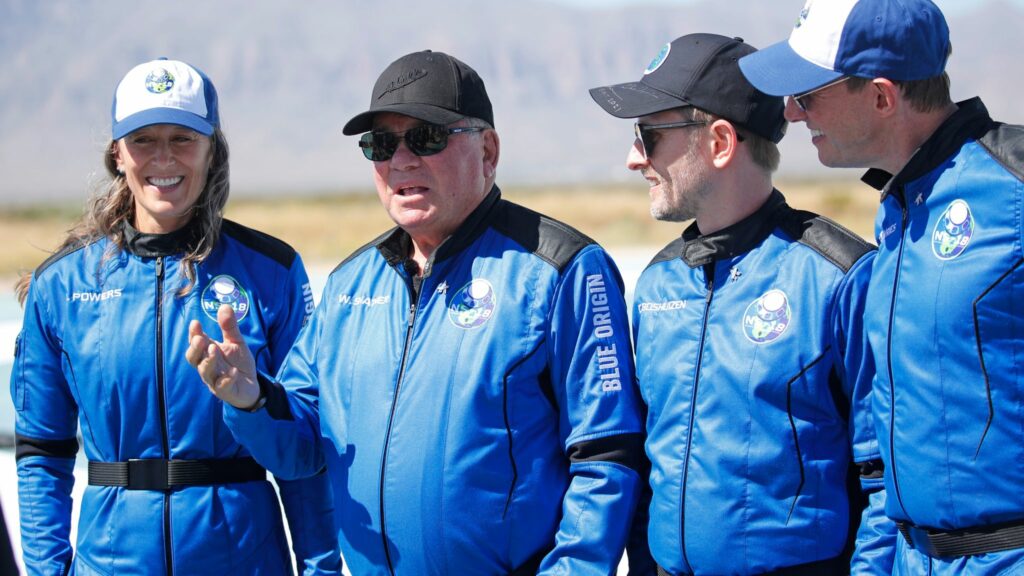
WaPo (“William Shatner, Star Trek’s Capt. Kirk, flies to space and back, adding to this year’s number of civilian astronauts“):
William Shatner, who as Capt. James T. Kirk on the TV series “Star Trek” flew in the USS Enterprise around the galaxy, on Wednesday reached the edge of space on a more modest quest and on a far less capable spacecraft — but on a mission that had the distinct advantage of being real.
Shatner and three other passengers lifted off at 10:49 a.m. Eastern time from a launch site in West Texas owned and operated by Jeff Bezos’s Blue Origin space company. The launch was the venture’s second human spaceflight mission, and it came three months after Bezos himself flew to space on his company’s New Shepard rocket.
Lasting just more than 10 minutes, the autonomous vehicle, named for Alan Shepard, the first American to reach space, climbed to a height of about 66 miles, four miles beyond one measurement of what is generally considered the edge of space. Aloft and free-floating above the Earth, the crew took in views of the planet below and the dark skies beyond while they experienced weightlessness for a few minutes.
The capsule then touched down under parachutes in the desert as the company celebrated what appeared to be another successful mission. Shatner, 90, became the oldest person to have visited space.
The actor waxed poetic about the experience:
After the mission, an emotional and philosophical Shatner rhapsodized about the experience to Bezos, who greeted the crew at the landing site and opened the spacecraft’s hatch. (Bezos owns The Washington Post.)
Shatner compared tearing through the blue sky on the rocket to whipping a comfortable blanket off in the morning. “And you’re staring into blackness,” he said. “That’s the thing.”
The line of the atmosphere, “which is keeping us alive, is thinner than your skin,” he said. “It’s a sliver. It’s immeasurably small when you think in terms of the universe.”
The contrast of the bright colorful Earth and the inky vastness above was a metaphor for life and death, he said. “What you have given me is the most profound experience I can imagine,” he told Bezos. “I’m so filled with emotion about what just happened. It’s extraordinary. I hope I never recover from this. I hope I maintain what I feel now. I don’t want to lose it.”
Which contrasts with the reality that what is now extraordinary could soon become routine:
The launch became part of a historic year in which the number of private astronauts who have reached space outnumber those sent to space by NASA, the start of a new dynamic that is beginning to open up space to ordinary people.
Shatner’s flight was the sixth human spaceflight mission this year carrying civilian astronauts who have not received government training. Earlier this year, Richard Branson’s Virgin Galactic flew its space plane to the edge of space twice — once in May with a pair of pilots, and a second in July with Branson himself, three other passengers and two pilots.
Less than two weeks after Branson’s flight, Blue Origin flew Bezos and three others to the edge of space. Last month, Elon Musk’s SpaceX flew the Inspiration4 mission, which carried a crew of four amateur astronauts into orbit, where they stayed for three days inside the Dragon spacecraft.
And earlier this month, Russian actress Yulia Peresild and producer-director Klim Shipenko lifted off on a Russian rocket to shoot scenes for a film while aboard the International Space Station.
If all goes to plan, there could be as many as nine flights this year with amateur astronauts on board. Virgin Galactic has said it’s planning one more, as is Blue Origin, and Japanese billionaire Yusaku Maezawa and an assistant — who would document the flight — are scheduled to fly on the Russian Soyuz to the ISS. (More private astronaut missions are scheduled for next year, and Axiom Space plans to fly a crew of four to the ISS on a SpaceX rocket.)
Obviously, this is an experience currently reserved for those who are rich, famous, and connected. But that was true in the earliest days of airplane travel. It went from a daring invention in 1909 to the stuff of adventure fantasy in the 1910s to a weapon of war and something available to the middle class in the 1920s.
It’s doubtful that space travel will become as ubiquitous as commercial aviation, simply because there’s less obvious utility.

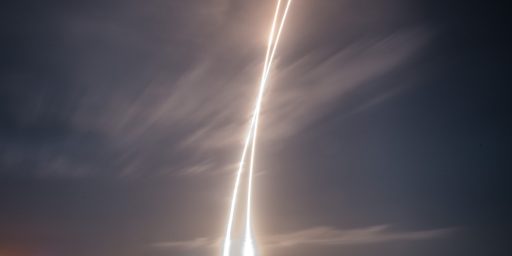
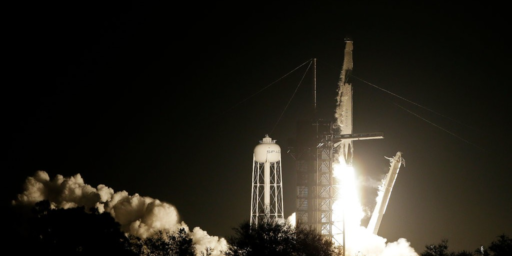
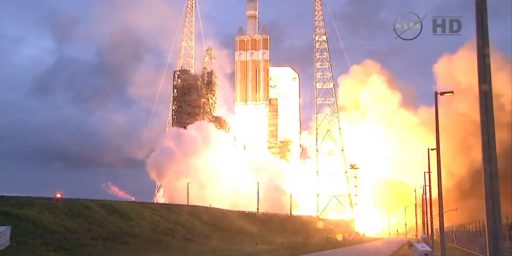

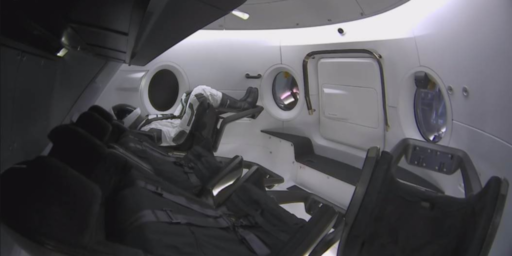
Classy of them to name it for Alan Shepard. I think he’s the person who first remarked that sitting there on top of that Redstone rocket he reflect that it had been built by the lowest bidder.
And it would be interesting (but not important, I guess) to know how Bezos and Shatner got together. Did Bezos reach out because he has memories of Star Trek? Was some other party involved, introducing them? A human interest story I haven’t heard.
With the rapidly increasing number of civilians in space, is anyone cataloging their reactions? Would be a shame if the first wave of untrained ‘explorers’ had their subjective experiences scattered on the winds.
@JohnMcC:
It was probably Bezos who reached out to Shatner, since Bezos claims to have been obsessed by Star Trek even as a small child. Shatner carried some of Bezos’ ST toys with him into space.
These days I’m thinking more Futurama that Star Trek as regards an optimistic view of space travel.
Fry: That clover helped my rat-faced brother steal my dream of going into space. Now I’ll never get there.
Leela: You went there this morning for doughnuts.
There must be two things to make space travel as common as air travel: 1) it needs to become routine, and 2) there needs to be somewhere to go.
The latter includes somewhere you can go and survive for long periods of time, not just get there.
We can’t meet these conditions as of now.
There’s also much focus on space travel as tourism. Think more of sea travel throughout time rather than air travel. By far, most sea travel has involved trade rather than tourism, even in the golden age of transatlantic passenger liners. People fo from A to B to pick up goods to take back home, not to visit B (that’s a side benefit).
As of now, there’s nothing worth the price of going to the Moon, Mars, Venus, Jupiter, etc., to bring back to Earth. except for exploration and scientific research. Plenty of scientists would love samples of Mars, Venus, Jupiter, etc. to study, and better yet to set up observational instruments in these places.
That’s a worthwhile endeavor, but an expensive one. It also doesn’t produce much in the way of material returns (ie money), so there’s no incentive to fund it, past what already exists from governments and some non-profit organizations.
Were the Apollo astronauts entranced by what they saw and experienced on the Moon? NO doubt. But that’s not why they went there. Geopolitics aside, they were there to make observations, plant instruments, and gather samples for study.
@Kathy:
This is the thing. And the older I get, the more the romance of my youth that there would be somewhere to go fades considerably. The practicality of colonizing the moon, Mars or the asteroid belt just is nowhere near even a fantastical possibility as best as I can tell.
@CSK: I agree that Bezos probably initiated this. Without a “draw” people will quickly stop noticing that he’s going into space.
@Joe:
What will Bezos do for an encore?
@Kathy: @Steven L. Taylor: Yes, the lack of “somewhere to go” is what I meant by “less obvious utility.” It’ll likely be closer to hot air balloon and blimp rides than commercial aviation for that reason. I can imagine thousands of people wanting to go for the thrill of it once this is proven safe, though.
@CSK:
His planned encores are rapidly failing. Blue Origin lost out entirely with its bid to build a lunar lander. The BE-4 engine seems to be in a lot of trouble. The Washington Post published an investigative piece talking about the “toxic” culture and that the C-suite people are completely out of touch with the people actually doing the work.
The BE-4 problems seem to me particularly notable because the United Launch Alliance has bet their future commercial heavy launch business on it. Seems remarkable to me that Bezos could wind up handing that whole line of business to SpaceX.
@James Joyner:
I have to doubt the long-term viability of the business. Every one of these launches causes significant disruption to commercial air traffic routes. That alone is going to sharply limit the number of trips available.
This is part of a series of ongoing orbital experiments: whether a ham ages quicker in space.
@Steven L. Taylor:
@James Joyner:
Cost is a huge issue, too. The famous voyages of the 15th and 16th centuries were not cheap, but there was the expectation they’d pay off. The big difference, is the Europeans knew what was on the other end: spices and silk, and other coveted goods from Asia. The exploration aspect was finding sea routes there, so as to bypass the largely Arab traders which brought such goods overland.
Granted these Asian goods were overpriced and mostly served a luxury role (it had been so since Roman times), but they were could not be grown or made in Europe.
What’s on Mars, or the asteroids, or the Moon? we have a notion due to the probes we’ve sent. But what minerals may exist there, also exist on Earth. Mining iron or aluminum is not cheap here, but it would be far more expensive off-world. So that’s out.
Some elements are scarce on Earth which might be plentiful elsewhere. As yet, I know of none.
Absent that, it will be all science and tourism, and that’s also very expensive.
So, if it cost as much to send thousands of tons to the Moon as it does to ship them across the Atlantic or Pacific, then it might make sense to move mining operations there. This doesn’t seem like a realistic option.
To illustrate how important “having somewhere to go” is, consider Antarctica. Getting there is not outrageously expensive, but there’s nothing there. So you have scientists and tourists, and nothing else (maybe when the ice melts and we can turn the whole continent into prime arable land? who knows).
There aren’t any services which might be provided, either. There are plenty in Earth orbit, and those are handled with largely automated satellites of various kinds. So there is no need to go where there is somewhere to go.
@Kathy:
Well, someone might try to throw a “no destination wedding” as opposed to a “destination wedding.”
@Kathy:
That is an excellent comment. To add an additional observation in the 15th and 16th centuries the explorers expected to find people everywhere they went because people had been practically everywhere for millennia at that point.
I like Shatner, but the whole thing left a sour taste in my mouth. Bezos and his ludicrous cock rocket and chorus of paid toadies strutting around like he was Francis Drake. Calling tourists astronauts FFS.
@Kathy:
I’ve been considering it for at least 20 years now, maybe more. Antarctica is the only significant land on earth not claimed by a nation-state. (Setting aside Argentina and Chile because they’re Argentina and Chile.) I’ve wanted to set a big sci fi epic on Antarctica, but I always consider the economics of world-building, and I have not yet found a way to make it work. Fossil fuels buried under two miles of ice? The fisheries? Commemorative postage stamps? The only way to make it work is in some James Bond supervillain scenario.
@Michael Reynolds: Learning that the basis of the invitation was Mr Bezos’ childhood love of Star Trek, I wondered if Mr Shatner’s nickname from now on might be ‘rosebud’?
@JohnMcC:
I strongly suspect that Bezos’s love of Star Trek was manufactured in his P.R. department. Watch the tape of Shatner trying to talk to Bezos immediately after. The smug prick ignores Shatner like he’s Grandpa Simpson yelling at clouds. It’s a very cringeworthy moment, and revealing of Bezos’s narcissism.
I can see someplace to go with space travel…Australia or South Africa (if in the US). If it can be made cost effective for high speed travel by people and/or cargo to replace day long flights it can develop that way.
And the military applications of being able to deploy that rapidly around the planet I’m sure are being investigated as well.
@Michael Reynolds:
You might want to check “A World Out of Time” by Larry Niven. In the far, far future, after wars, dictatorships, and remodeling the Solar System, the only livable parts of Earth are the tip of South America, Antarctica, and the top of the Himalayas.
Consider there’s very little vegetation in Antarctica, so the land underneath all that snow and ice ought to have a full complement of nutrients. What if fertile, arable land is far more valuable than all the oil in the present world, given what’s not flooded is too hot to live or exhausted?
@David Schuler:
The bonus this time around is there are no people on Mars or the Moon.
@Just Another Ex-Republican:
There’s talk now and then of suborbital, hypersonic transports, which would work like slower, gentler, ICBMs do. Musk even began to hype the idea for his Starship rocket.
the simple idea is to mount a spaceplane on a booster, so it can glide to its destination past re-entry, around Mach 6 or 7, I think.
You could do NYC to Sydney in a couple of hours or less (effective flight time), but 1) it would be hugely expensive, 2) it might face weather delays, 3) rockets are not nearly as reliable as jets, and 4) the launch sites would need to be rather far from cities.
On the plus side, you’d get a higher altitude, and tens of minutes of microgravity.
Yeah, this smells like a PR stunt to me. It’s a smart one, and of all people, I am glad that Shatner got to go. If anyone deserves to be a space tourist, he does. His reactions will give Bezos some undeserved good press, unfortunately, but I don’t think it’ll be more than a drop in the bucket compared to Bezos’ bad reputation, at this point.
So I’m fine with this.
@Kathy:
I wonder about the environmental cost of rocket launches as well.
@Michael Reynolds:
Very high. But there are relatively few launches per year.
It varies, too. SpaceX uses kerosene and oxygen in the booster stage. that’s pretty much jet fuel, but several times more tons than even an A380 burns over several flights.
The Shuttle used hydrogen and oxygen on the main engines, which ought to produce no CO2 at all. On the other hand, water vapor is also a greenhouse gas. and the side solid boosters burned who knows what metallic compounds and what kind of solid oxidizer.
No idea what Bezos’ phallic rocket burns, but if he’s going to be doing dozens of launches a month,m he really shouldn’t.
@Kathy:
Pull 2-3 G’s at launch, reentry turbulence, some sort of physical and suiting up at the launch end, plus all the things you mention. 1,600 mph supersonic with enough fuel will put you anywhere in the world in eight hours. Anywhere in the same hemisphere where you start in four hours. With a sufficiently clever design, fly in or out of high-end general aviation airports. There must be at least a half-dozen companies putting money into that. Those are going to sharply limit where the rocket approach has a total time advantage.
@Kathy:
SpaceX Starship and Heavy Lifter, and Blue Origin’s BE-4 engine, are all methalox: super-cooled liquid methane and liquid oxygen. I don’t know how Blue Origin settled on it. SpaceX, at least as I understand it, worked backwards from the constraints imposed by (a) orbital refueling and (b) feasibility of manufacturing it on Mars.
@Michael Cain:
No question. I went for the simple idea. there ahve been other proposals.
Take the National Aerospace Plane. That could have operated from most airports. You could steal a page from Rutan’s book (stolen from the Air Force’s book) and air launch from a bigger carrier plane. Or just slap on some JATO-style boosters, to be ignited at 20-30,000 ft or so, maybe only over water.
BTW, I kind of recalled some proposals for retirement homes in orbit, given the microgravity environment would allow enfeebled seniors to move about more easily. The same would go for people with disabilities which impede their mobility.
More sophisticated notions involve a spinning wheel design (see 2001, they get that entirely right), with variable levels of gravity, from weightless to 0.5 g, say, for the same reason.
Of course, such places would require a staff, and dedicated medical personnel to handle all healthcare needs and emergencies, and engineers to keep the place running, room for guests to visit, etc. Next thing you know, the old folks home on the high frontier is a small orbital city demanding representation in Congress.
@Kathy:
Near the end of my technical career, some of the higher-ups hauled me along to some meetings and I got to fly on the corporate jet. It is surprising how much time is saved by (a) skipping the commercial terminals, (b) leaving promptly when the last passenger arrives, rather than to a hard schedule, and (c) literally met and dropped off at the airplane door by a private car and driver at the destination airport.
I had to do Denver-to-the-West-Coast one day round-trip meetings by commercial air. Feasible, but a long tiresome day. The same trip by corporate jet was a piece of cake.
@Kathy:
I endorse this idea enthusiastically. It’s looking likely that our younger daughter will start dropping rugrats in a few years. And of course we would love to babysit, but darn it, we’d be in space, so what could we do?
My support presupposes we’d have decent internet. And at least a handful of decent restaurants. Otherwise, no.
@Michael Reynolds:
So, big spinning wheels with 0.5G it is. Although, there has to be at least an interesting short story about the first chef to discover some exciting zero-G cuisine that couldn’t be done in gravity.
@Kathy:
Imagine an Arthur C Clark 2001 spinning wheel station as a place.
A casino with a Restaurant At the End Of The Atmosphere or some-such. Everybody who’s anybody will simply HAVE to go. Inner rings could offer low to zero G game rooms. The patrons can laugh at the unwashed masses in Vegas below.
@Michael Cain:
I’m still waiting on the new drugs and revolutionary materials that can only be made in zero g, which we were promised in 1981 when the first Shuttle launched.
I think since then we’ve had new drugs and revolutionary new materials produced in 1 g. I’m certainly impressed by the mRNA vaccines.
@dazedandconfused:
Partly it depends on how long the billionaire space race goes on, and when bezos decides he can’t, or won’t just keep spending money on his hobby.
There was a company, Bigelow Aerospace, which appears to have folded last year, working on inflatable habitation modules for use as space hotels in orbit.
Someone else will try and eventually succeed.
@Kathy:
When I drag out my old technology forecasting hat, I am always interested in the question, “What did we miss?” Circa 1980, materials science was all about bulk materials. It was years until we learned that the interesting new things were nanostructured, atom(s)-thick films. And that those were as easy to do — perhaps easier — in gravity than in free fall.
@Kathy:
At this particular moment, I would entertain a bet that was roughly, “The inflatable part will be anchored on some version of Starliner, with multiples of them tied together.” At this particular moment, I believe that no one else is asking questions about a multiple-mission multiple-configuration platform. Given absolute control of the US space program today, I would kill the ULA’s Artemis effort in a heartbeat. There is no benefit to reproducing Apollo with better materials and software, at $2B per launch.
This is really stupid. A 10 minute ride. For how much? Why not just burn a big pile of money? Not as exciting but it would last longer and you could post a video on Facebook so everyone can see how stupid you are.
I’d rather go on a tour of the country’s greatest roller coasters while handling out $100 tips.
@Kathy:
Granted, I’m a astronomer, so optimism on this subject is in my blood. But:
1) energy — solar satellites, helium 3, etc.
2) minerals – asteroid belt would make conflict minerals irrelevant and power alternative energy indefinitely
3) space — I suspect that will come a time when we have no choice because of changes to the Earth’s climate or other things (not overpopulation, which seems like it will not be a problem).
I admit that the possibilities seem to have faded a bit. It’s a subject I’m wrestling with in the novel I’m writing.
@Hal_10000:
I vaguely recall reading there are or may be large deposits of helium 3 on the Moon. the problem is first we need to have fusion reactors.
Arthur C. Clarke, a big promoter of space travel since before Sputnik I, went into great detail about all the benefits we could derive from having satellites in orbit. He assumed their operation would require people at the controls, as electronics in the 1940s were not particularly reliable (he spent WWII serving at RAF radar stations).
He was wrong. had he been right, though, we’d have a permanent population in orbit by now. It would be cheaper to build schools, shops, hospitals, theaters, and even factories in orbit, than to rotate crews from several space stations to Earth every few months.